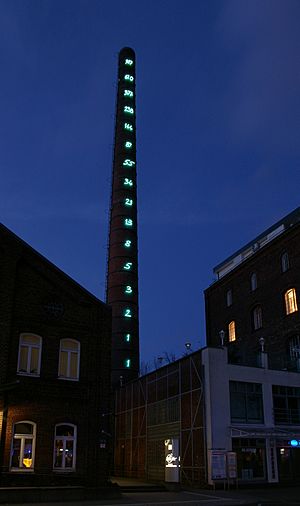Mario Merz facts for kids
Quick facts for kids
Mario Merz
|
|
|---|---|
 |
|
| Born | 1 January 1925 |
| Died | 9 November 2003 (aged 78) |
| Nationality | Italian |
| Known for | Sculpture and Painting |
| Movement | Arte Povera |
Mario Merz (born January 1, 1925 – died November 9, 2003) was an Italian artist. He was married to fellow artist Marisa Merz.
Contents
Life of Mario Merz
Mario Merz was born in Milan, Italy. He started drawing during World War II. At that time, he was imprisoned for being part of an anti-fascist group called Giustizia e Libertà.
While drawing, he tried a special technique. He would not lift his pencil from the paper, creating a continuous line. He was interested in how nature and people connect. In the 1950s, he had his first art shows in Turin. This city was a lively place for new ideas.
He met his wife, Marisa Merz, while studying in Turin. Both artists were important in developing an art movement called Arte Povera. They also influenced each other's artwork.
Mario Merz passed away in Milan in 2003.
Exploring Mario Merz's Art
Merz wanted his art to connect with the world around us. He showed how something small, like a seed or a leaf, could represent a whole universe on his canvas.
From the mid-1960s, he explored how energy moves from living things to non-living things. This led him to create art where neon lights went through everyday items. These items included umbrellas, glasses, bottles, or even his own raincoat.
Using Fibonacci Numbers in Art
Many of Merz's artworks featured words or numbers made of neon lights. The numbers often followed the Fibonacci sequence. This is a special mathematical pattern found in nature. It shows how things grow, like leaves, snail shells, and pine cones.
The Fibonacci sequence starts with 1, 1. Then, each new number is the sum of the two numbers before it. So, it goes 1, 1, 2, 3, 5, 8, and so on.

From 1969, Merz used this sequence in his art to show how things are created and grow. He placed these neon numbers on famous buildings. For example, they climbed the Guggenheim Museum in New York (1971). They also appeared on a tall spire in Turin (1984). One installation of Fibonacci numbers by Merz is a famous landmark. It is at the Centre for International Light Art in Unna, Germany.
Igloos and Arte Povera
In the 1960s, Merz's work with energy, light, and materials made him part of the Arte Povera movement. This Italian art movement used simple, everyday materials. It was one of the most important art movements in Italy in the 20th century.
In 1968, Merz started making his famous igloo sculptures. He continued making them throughout his life. These igloos showed ancient and tribal ideas hidden in modern times. He saw the igloo, a shelter for people who move around, as a perfect symbol for an artist's space.
His first igloo, "Giap's Igloo" (1968), had a quote from General Vo Nguyen Giap. The quote was: If the enemy masses his forces, he loses ground. If he scatters, he loses force.
Later in his career, Merz also added other items to his art. These included stacks of newspapers, animal shapes, and motorcycles. He also used tables, which symbolized people's need for connection.
Later Works and Collaborations
From the late 1970s, Merz sometimes returned to more traditional art forms. In his work Le Foglie (The Leaves) (1983–84), he used gold leaf squares. These were scattered around two large, leaf-shaped forms. He even carved in marble sometimes. In 2002, he made five marble statues. They were displayed from the windows of a building in Carrara, Italy.
Merz believed that "Space is curved, the earth is curved, everything on earth is curved." Because of this, he created large curved art installations. One famous one was at the Guggenheim in New York.
In 1996, Merz worked with fashion designer Jil Sander for a fashion show. They created a "wind tunnel" made of white fabric. It was filled with blowing leaves and flowers. This showed how art and fashion could come together.
Art Exhibitions
Mario Merz had his first solo art show in 1954 in Turin. His first solo museum exhibition in Europe was in 1975 in Basel, Switzerland.
He had many solo exhibitions around the world. These included shows at the Solomon R. Guggenheim Museum in New York (1989). His art was also shown at the Museum of Contemporary Art, Los Angeles.
Merz also took part in the important art exhibition documenta several times. He participated in 1972, 1977, 1983, and 1992.
Awards and Recognition
Mario Merz received several important awards for his art. These include the Ambrogino Gold Prize from Milan and the Oskar Kokoschka Prize from Vienna. He also won the Praemium Imperiale for sculpture in 2003.
A film about him, called Mario Merz (2002), was made by artist Tacita Dean. The Fondazione Merz in Turin, Italy, is a foundation named after him. It shows his artworks and supports new artists.
Art Collections
- Centre for International Light Art (CILA), Unna, Germany
- Hallen für Neue Kunst Schaffhausen, Switzerland
Contributions
- Life on Mars, the 2008 Carnegie International Mario Merz - Signals
Legacy
The Fondazione Merz was started in 2005 in Turin, Italy. It was founded by Mario Merz's daughter, Beatrice. The Mario Merz Prize, an award for artists, was launched in 2015.
See also
 In Spanish: Mario Merz para niños
In Spanish: Mario Merz para niños

